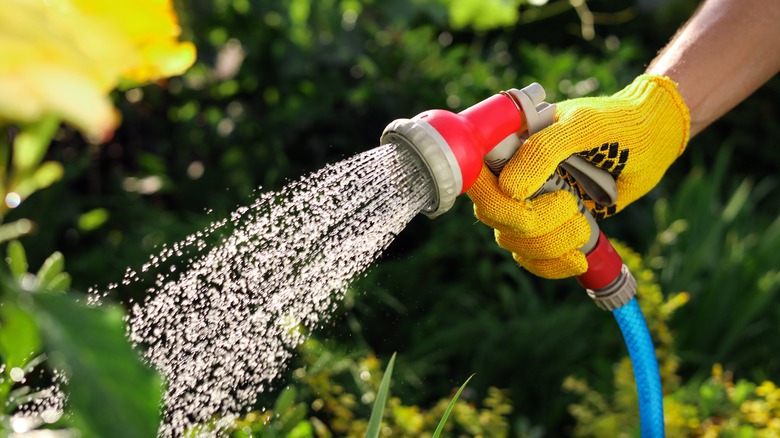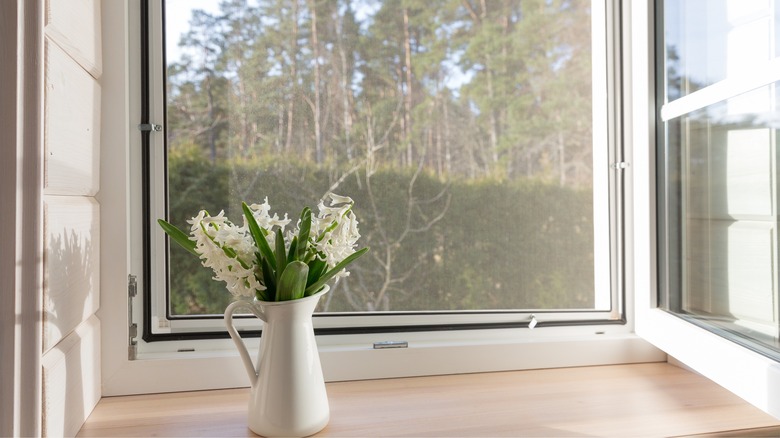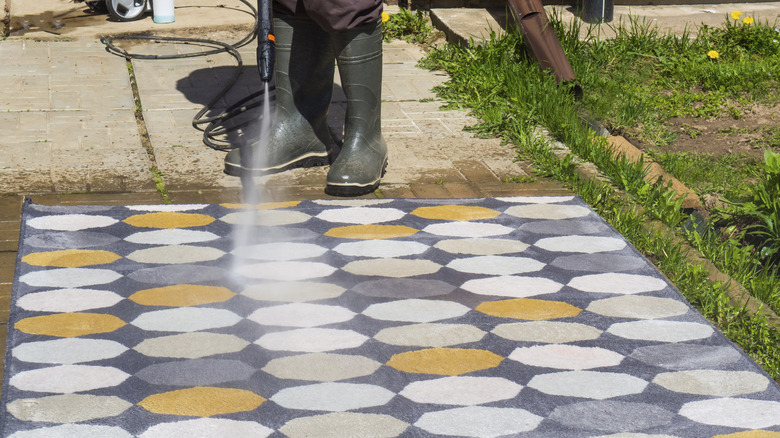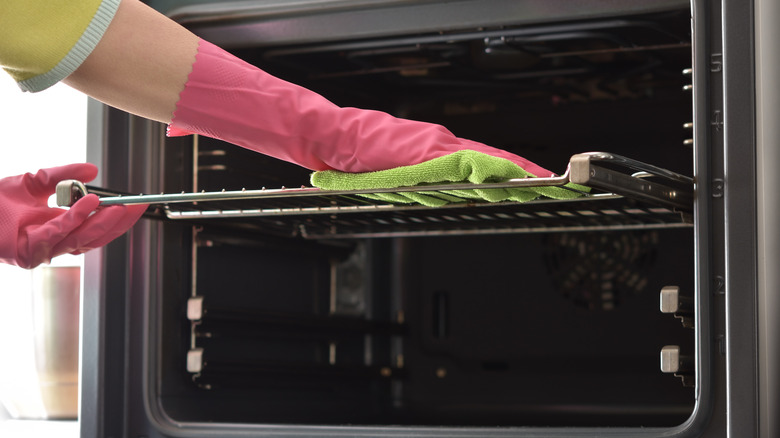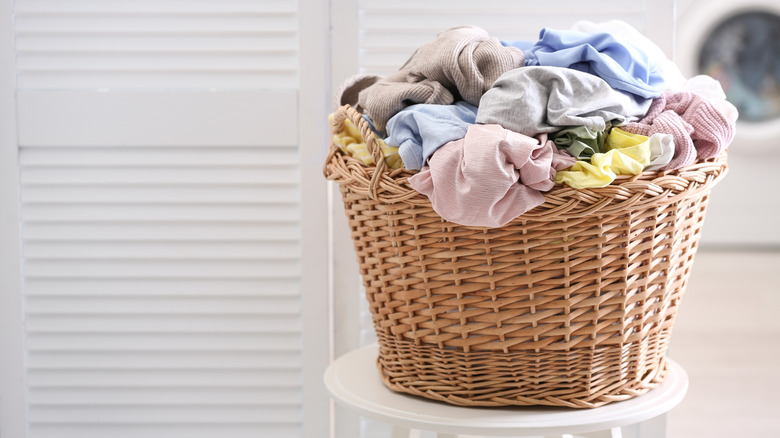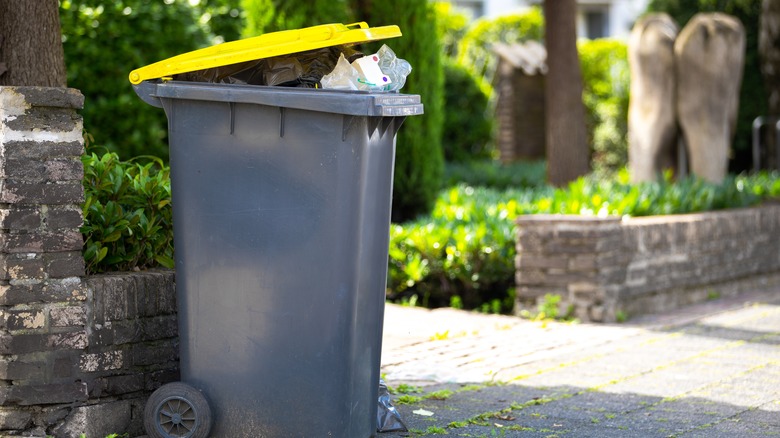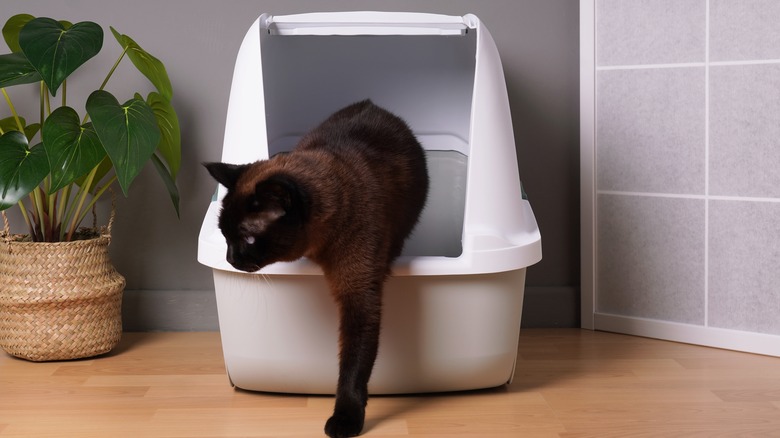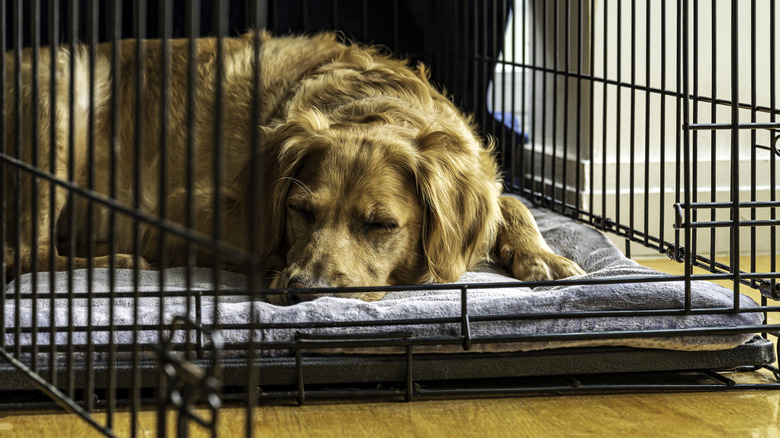Household Items You Should Be Cleaning With Your Hose
The usefulness of your standard garden hose isn't limited to outdoor tasks. It can actually be the perfect tool for cleaning numerous items around the house, especially large, bulky items that you may be tired of wrestling into the bathtub. Some items will be good as new with a simple rinse, while others may require scrubbing with a specific cleaning agent to cut through stubborn stains or grime.
Now, before your cleaning frenzy takes off, do a quick check to make sure your hose is in good working order. If it's cracked or no longer works correctly, be sure to buy a new hose. With various materials, soaker types, and expansion capabilities, there are tons of options perfect for cleaning your household items. Once everything is in order, read on to learn how to update, optimize, and overhaul your cleaning routine just by utilizing this overlooked but highly effective tool.
Window screens
If you can't remember the last time you cleaned your window screens, or you know for a fact that you've never done it, consider this a friendly reminder! We rely on screens to bring fresh air into our homes while simultaneously keeping bugs and curious critters out. However, if too much gunk, like pollen, bird poop, dirt, and other debris, builds up on the screens, it can begin to affect your indoor air quality. Because they're large and cumbersome, washing them can be a challenging task. And, that's why using your hose is the perfect solution.
To remove your screen, fully raise the lower sash and look for tabs or clips towards the bottom. Next, slide them to release the screen from the frame and raise it slightly. After this, you should be able to push it out, turn it on its side, and fully remove it from the window.
Lay the screens in the grass or your driveway. Rinse with the garden hose, and then wipe down with a mixture of three parts water to one part vinegar. Then use a soft brush to scrub both sides of the screen. After a final rinse, wipe dry with a clean cloth and allow to air dry before reinstalling.
Rugs
Day-to-day living subjects household rugs to all sorts of dirt, odors, and bacteria. Whether it's gunk being tracked inside on shoes or dander and fur from beloved pets, plenty is lurking in the fibers of indoor and outdoor rugs. Instead of going through the hassle of renting a carpet cleaner, or the expense of hiring professionals, allow your garden hose to do the job for you. It's a cost-effective chore that can be tackled easily on a sunny afternoon and a great way to help keep your rug clean. However, heirloom or vintage rugs must be excluded from this, as these delicate pieces should only be cleaned by a professional.
First, you'll need to create a sturdy station outside. Depending on the size of your rug, two sawhorses may be sufficient, but for larger area rugs, try attaching a strong rope between two trees. A traditional clothesline might not be able to bear the weight of the wet rug. Next, ensure that the rug has been vacuumed thoroughly, and spot-treat any stains before moving it outside. Once it's hanging up, saturate it completely with the hose. Next, apply carpet shampoo and vigorously scrub with a strong, handheld brush. Rinse with the hose until the water runs clear. You don't want to leave any shampoo residue behind. Finally, allow the warm sunshine and fresh air to dry your rug completely before returning it to the house.
Oven racks
Forgot to clean the excess cheese from your frozen pizza last week and now it's fossilized inside your oven? Or maybe you're hoping it'll eventually bake itself off with enough heat. Though most ovens are equipped with a self-cleaning feature, there are other ways to clean your oven without harsh chemicals or blazing hot temperatures. All you need is your garden hose, some dish soap, and a sponge or brush.
Due to their bulky size, oven racks can be awkward (or even impossible) to wrestle into your kitchen sink for cleaning. Taking them outside will save you time and sweat equity. Begin by hosing them off until they're thoroughly saturated. Next, grab your sponge, suds it up with dish soap, and scrub away the burnt residue. If any debris is particularly stubborn, you may need to rinse and repeat the process. Once everything is clean, give a final rinse with the hose and leave to dry in the sunshine on some towels.
Outdoor furniture
Though they can be an expensive investment initially, outdoor furniture such as rocking chairs, chaises, and benches can transform any ordinary outdoor space into a relaxing oasis. With proper upkeep, like regular cleaning and safe storage during the winter months, outdoor furniture should last through numerous seasons. As long as it's made from wood, metal, plastic, resin, or fabric, experts support using a garden hose as a vital part of your cleaning process.
As you're pulling your furniture out from its wintertime storage, a quick, initial spray down with the hose is a great way to remove cobwebs, dust, and other debris. Once all of that is rinsed away, you can better evaluate the state of the furnishings. Do they need a fresh coat of paint or stain? Is there any rust or mold that needs to be addressed? If none of these problems exist, you can move forward with a soapy cleaning. Fill a bucket with warm water, add ¼ cup of dish soap, and use a soft sponge. Harsh cleaners and abrasive sponges or scouring pads should not be used on outdoor furniture. Once all the grime has been washed away, give a final rinse with the hose and allow it to dry in the sun.
Laundry baskets
Laundry baskets are one of those strange things that make our lives much easier but we don't give them a second thought most days. For example, when was the last time you thought to clean the basket? Sure, you clean all of the dirty, grimy clothes that it holds but what about the basket itself? Whether you gravitate towards plastic, a fabric hamper, or a more traditional basket material like wicker, it needs to be cleaned occasionally. With their large size and sometimes unusual shape, you won't find a better place to clean them than outside with your garden hose.
On a sunny day, haul your plastic baskets outside. Bring along a bucket with some dish soap and a soft sponge. Scrub the nooks and crannies, rinse clean with the hose, and leave to dry. If you have wicker baskets without a fabric insert, you can clean them with soapy water and a very gentle stream from the hose. Just don't use a higher pressure setting on your nozzle or it might break. Because wicker's texture and absorbency make it more susceptible to mold, you'll need to ensure it has plenty of time to dry completely in the sunshine before bringing it back into the house.
Trash cans
There's a funky smell in your trash can, but you removed the smelly bag and the odor is still there. The stinkiness might be coming from the can itself. If you can't remember the last time you cleaned the bin, there's no time like the present. Whether it's your household receptacle or the rolling can outside, experts recommend using a garden hose to help get the job done efficiently and effectively.
In addition to your hose, you'll need rubber gloves, bleach, and a scrub brush with a long handle. If you're cleaning the outdoor bin, clean it right after your trash has been collected so that it's already empty. Begin by turning the can on its side and rinsing it out with your hose. Stand the can back up and add a gallon of water plus ⅓ cup of bleach to the inside. Thoroughly scrub both the inside and outside of the can, allowing the bleach water to sit for at least six minutes to ensure proper disinfecting. Then tip the can back on its side, rinse clean with fresh hose water, and leave to air dry in the sun.
Litter boxes
While cats are adored by pet owners for their hilarious antics, loving personalities, and adorable fuzzy faces, there's one aspect of cat life that isn't a fan favorite — litter boxes. No matter how often you clean the litter box for regular maintenance, an occasional deep clean is necessary to keep your feline happy and your house smelling fresh. Because boxes accumulate lots of litter dust and plenty of unpleasant stains and odors, it makes sense to do the deep cleaning outside with your hose rather than trying to wrangle the messy receptacle into your bathtub. Plus, this reduces the chance of any feces remaining on your household surfaces.
After you've cleaned out all the waste and disposed of the old litter (make sure you're wearing rubber gloves), grab your hose, some dish soap, and a scrub brush. Experts recommend mild soap rather than heavy-duty cleaners. Harsh ones can leave behind a scent that the cat doesn't like, thus causing it to reject the litter box and go elsewhere in your home. Once you've washed the box clean, leave it out to dry. You can then turn your attention to hosing down and scrubbing the scoop, its container, and any other litter box accessories.
Pet crates and cages
Whether you have large dog crates, guinea pig pens, or bird cages, all pet enclosures require regular deep cleaning to keep your animals healthy and odors under control. However, many pet owners may be tempted to skip deep cleaning due to the size or unusual shape of the cages. With the help of your garden hose, this chore goes from awkward to easy.
Before taking your pet's enclosure outside, remove all bedding, toys, and food bowls. Toss anything that's machine-washable into your washing machine and let it do some of the cleaning for you. Once the crate or cage is set up outside, spray it down to remove any loose hair or debris. Next, mix a solution with ½ cup white vinegar to one gallon of water and wipe down all surfaces with a soft sponge or microfiber cloth. Dish soap can also be used as an effective, gentle cleaner. However, if you're dealing with any unpleasant, stubborn odors, cleaning experts recommend the two in tandem. Begin with your soapy water, rinse, and then wipe everything again with the white vinegar mixture before giving a final rinse. Weather permitting, allow the crate to dry completely in the sun to avoid mildew growth.
